A lip-smacking instant gooseberry pickle or nellikai oorugai as we say in Tamil with frozen gooseberries! Yes, you read it right – pickle with frozen gooseberries. Check out how to make this super easy gooseberry pickle!
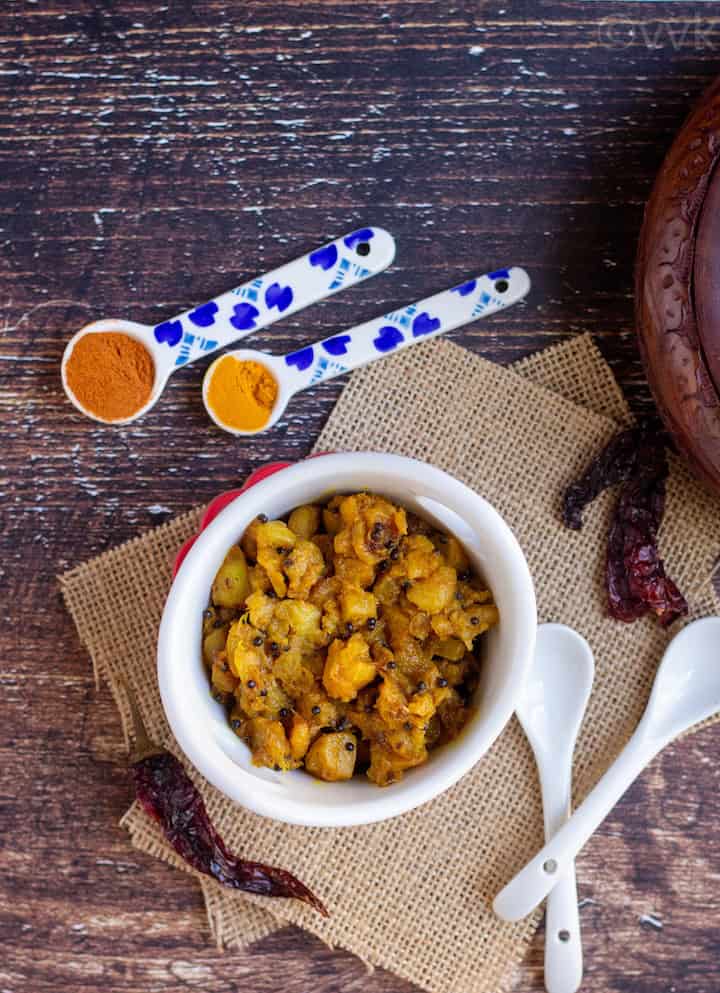
I love pickles, and this gooseberry pickle is one of my absolute favorites. I grew up eating both small star-shaped gooseberries (arai/ari/aru nellikai in Tamil) and big ones as well.
When we were in Pannaipuram, we had a big star-shaped gooseberry tree in our quarters, and mom makes both sweet and spicy pickles with it. The sweet ones are the best. She simmers the whole gooseberry in the sugar syrup and let it rest. The sour gooseberries soaked in sugar syrup are delightful treat folks. Ahhh, how much I miss fresh gooseberries.
Ok, let’s stay focused and get back to today’s recipe. In India, you can easily find fresh gooseberries, especially during the peak season. But here in the US, I haven’t seen fresh gooseberries. So I started getting frozen ones. You can find quite a few brands selling frozen amla. Here is the one that I bought. PS- this is not a sponsored post.
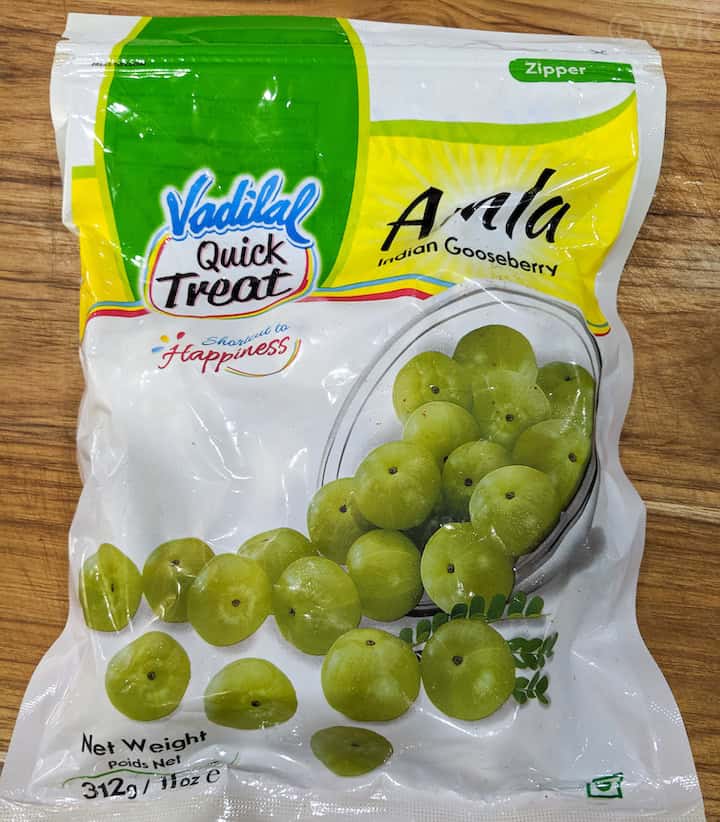
We all know amla/gooseberry is an excellent source of vitamin c and helps to improve our immunity and metabolism etc. The whole internet is full of its benefits, so I am not going to talk about it. But can we get the same benefits from frozen gooseberries?
Fresh Vs. Frozen Gooseberry-
I know it’s not fair to compare fresh and frozen fruits. I do agree nothing can beat the taste of fresh fruits. But when we can’t source fresh ones, we have to opt for the frozen ones.
Now the question is, do the frozen fruits retain the same amount of nutrition as the fresh ones? Bottom line, frozen fruits are nutritionally similar to the fresh ones. (We are not comparing to the freshly picked fruits here and assuming that the fruits are frozen at their peak ripeness) You can read about it on the Healthline website, and they have explained it clearly. There is some nutrition loss, but not significant.
After learning this fact, I am happily grabbing the frozen gooseberries from the groceries these days. I have some raita recipe coming up as well. So stay tuned!
Now here is the South Indian version of the amla pickle.
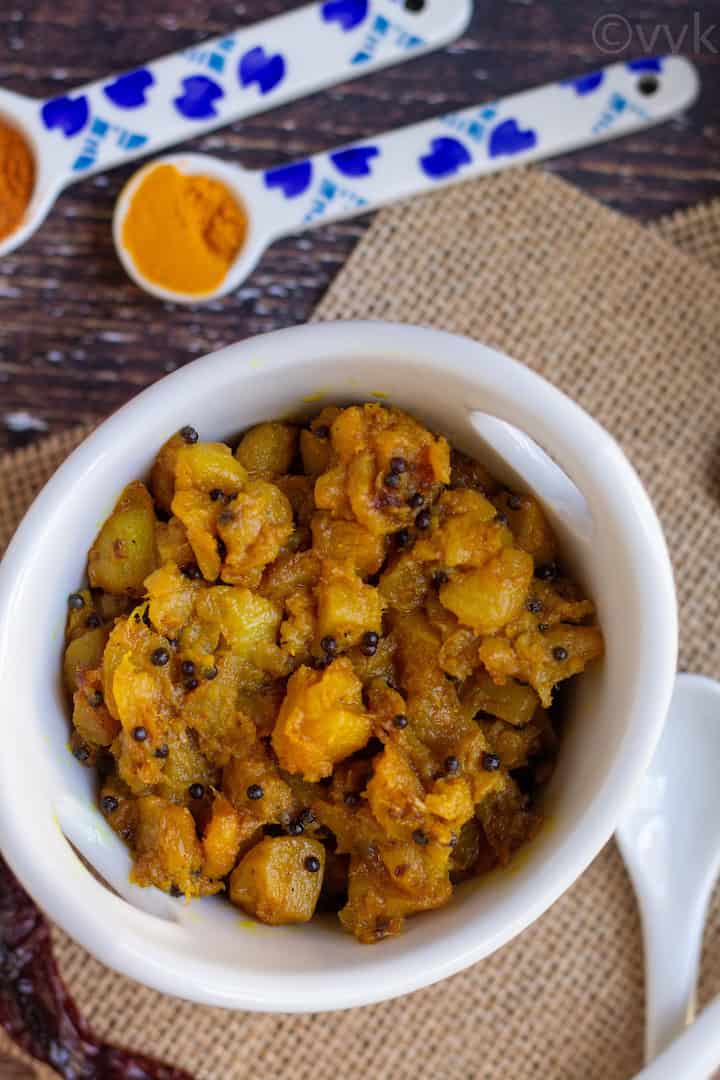
How to make gooseberry pickle?
Cook the gooseberries-
- Pressure cook/Steam the gooseberries in a pressure pan or cooker for 2 to 3 whistles. (Check recipe notes for cooking time) As you can see in the picture, I placed the gooseberries on a plate which I then placed on top of my rice bowl. I just drizzled about 2 to 3 tbsps of water on top.
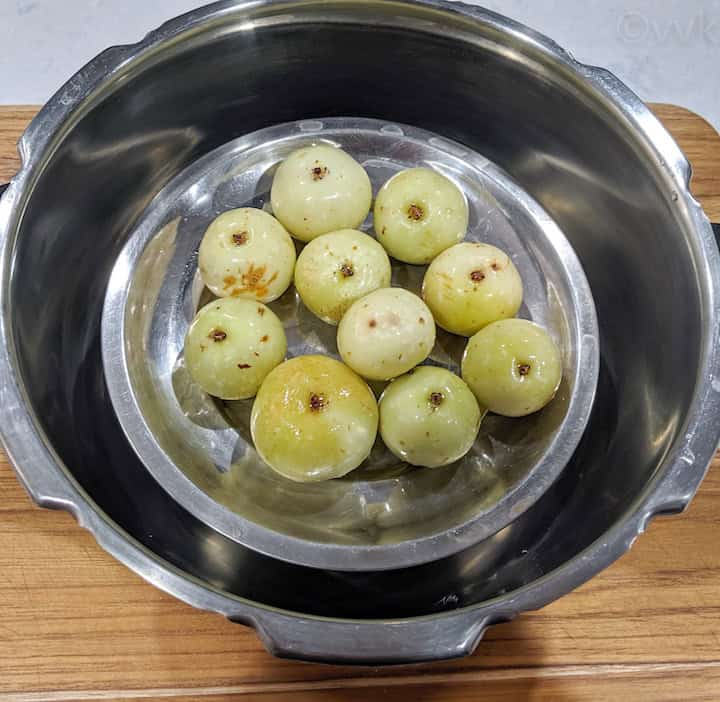
- You can pressure cook it in your preferred way. Let the pressure subside and let the gooseberries cool.
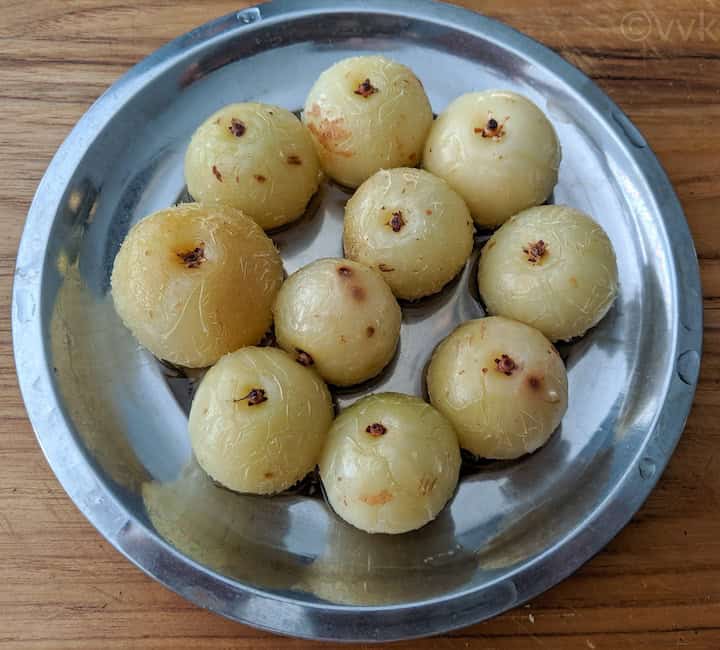
Deseed and chop the cooked gooseberries-
- It’s quite easy to deseed the cooked gooseberries. Just press the gooseberry, and it will break into two like below.
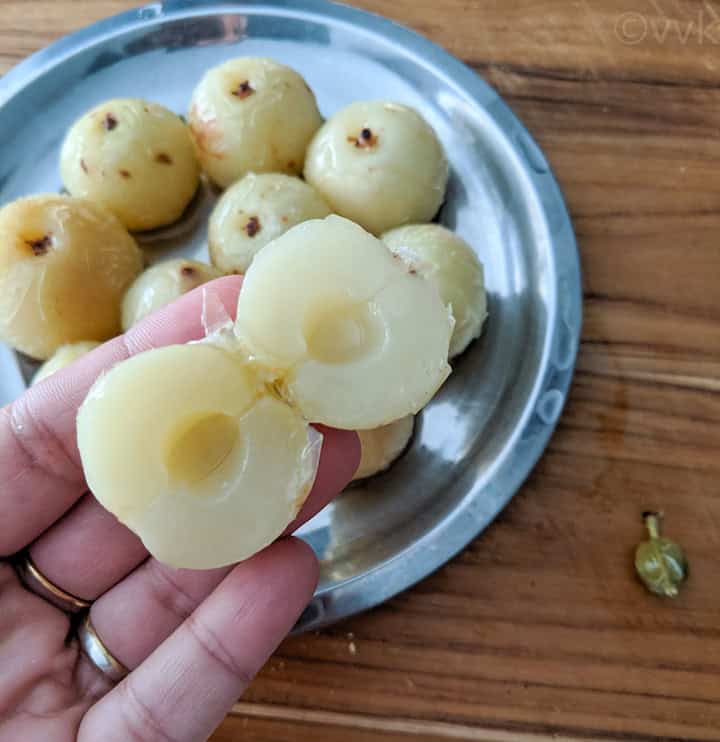
- Now remove the seeds and chop into small pieces.
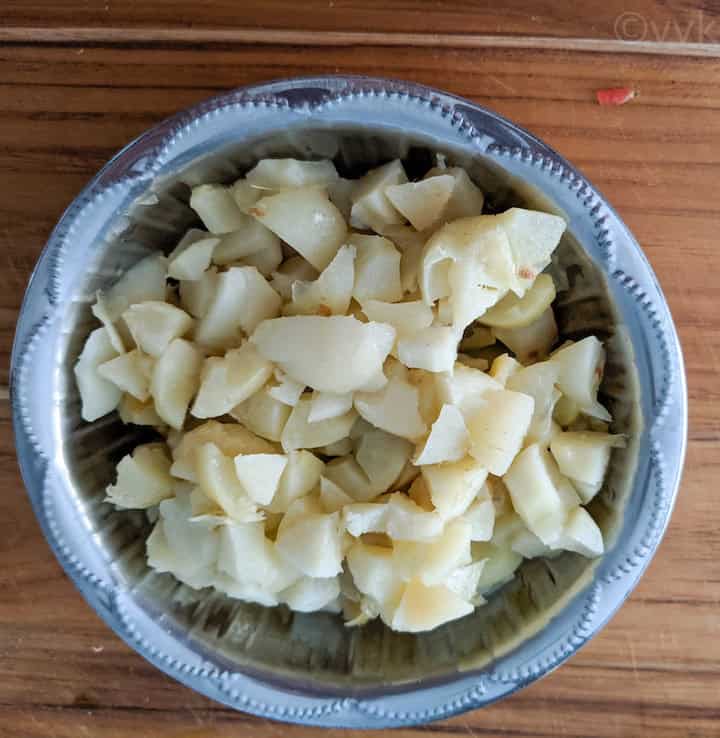
Prepare the pickle-
- In a pan or kadai, heat the oil. When the oil is hot, add the mustard seeds. When it splutters, reduce the heat and add the chopped gooseberries, red chili powder, fenugreek powder, turmeric powder, hing, and salt.
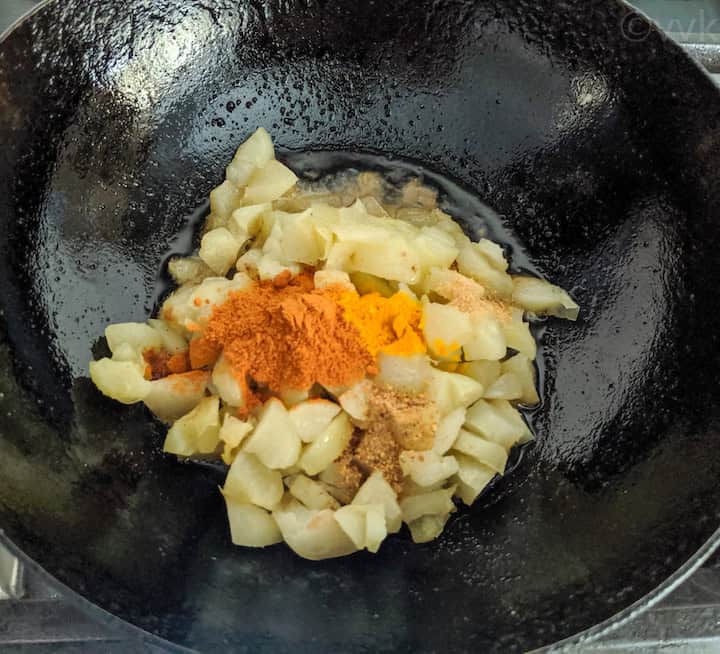
- Mix thoroughly. If you want to make it like thokku, mash the gooseberry while mixing. I did not mash it thoroughly. Check recipe notes for details.
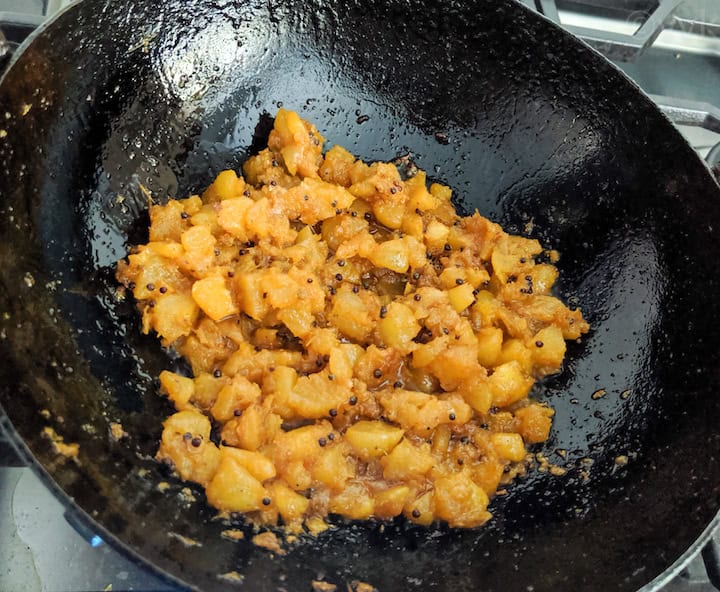
- Let it cook over medium-low heat for 5 to 7 minutes until the oil oozes out on the sides and top.

- Allow the pickle to cool and store the pickle in an air-tight container.
Recipe Notes-
- This gooseberry pickle stays good for months in the refrigerator. Make sure to use a clean spoon during every use.
- If you want to make this pickle like thokku (grated and mashed pickle), cook the gooseberries for four whistles. After removing the seeds, instead of chopping, you can roughly mash it also. Or, mash while mixing.
- Fenugreek Powder – If you don’t want to buy fenugreek powder just for this recipe, you can very well make it home. Dry roast 1 tbsp of fenugreek seeds until it turns light brown and crisp. Then grind it into a coarse powder. You can use it this fenugreek powder for pickles and kuzhambu also. My grandma roasts fenugreek and grinds it along with dry turmeric root and stores it. She always adds a pinch of this powder on top of sambar and vathal kuzhambu.
- You can also add ¼ tsp of mustard powder in this recipe. It’s a great preservative.
- I prefer gingelly oil or sesame oil for my pickles, but you can use regular cooking oil as well.
- As always, adjust the salt and spice according to your preference.
- Serving Size – You will get approx 1 cup of this pickle. The serving size that I mentioned below is approximate. It should yield a decent amount of 15 to 20 servings.

PS: Follow me on Instagram or join my Facebook Group for more gardening and recipe updates. If you try this frozen gooseberry pickle recipe, please don’t forget to comment and rate this recipe. If you have any questions, please leave a comment, and I will get to it asap. Make sure to follow me on my Pinterest for more healthy and delicious ideas!
📖 Recipe
Indian Gooseberry Pickle | Nellikai Oorugai
Ingredients
- 10 gooseberries frozen,the big green ones. Thaw it to room temperature
- 2 tbsp water or as required to pressure cook + water to add in the pressure cooker
- 3 tbsp oil preferably gingelly or sesame oil
- 1 tsp mustard seeds
- 1 tsp salt heaped tsp or to taste
- ½ tsp asafetida
- ½ tsp fenugreek powder vendiya podi
- 1 tsp red chili powder
- ¼ tsp turmeric powder
Instructions
Cook the gooseberries-
- Pressure cook/Steam the gooseberries in a pressure pan or cooker for 2 to 3 whistles. (Check recipe notes for cooking time) As you can see in the picture, I placed the gooseberries on a plate which I then put it on top of my rice bowl. I just drizzled about 2 to 3 tbsps of water on top. You can pressure cook it in your preferred way. Let the pressure subside and let the gooseberries cool.
Deseed and chop the cooked gooseberries-
- It's quite easy to deseed the cooked gooseberries. Just press the gooseberry, and it will break into two like below.
- Now remove the seeds and chop into small pieces.
Prepare the pickle-
- In a pan or kadai, heat the oil. When the oil is hot, add the mustard seeds. When it splutters, reduce the heat and add the chopped gooseberries, red chili powder, fenugreek powder, turmeric powder, hing, and salt.
- Mix thoroughly. If you want to make it like thokku, mash the gooseberry while mixing. I did not mash it thoroughly. Check recipe notes for details.
- Let it cook over medium-low heat for 5 to 7 minutes until the oil oozes out on the sides and top.
- Allow the pickle to cool and store the pickle in an air-tight container.
Notes
- This gooseberry pickle stays good for months in the refrigerator. Make sure to use a clean spoon during every use.
- If you want to make this pickle like thokku (grated and mashed pickle), cook the gooseberries for four whistles. After removing the seeds, instead of chopping, you can roughly mash it also. Or, mash while mixing.
- Fenugreek Powder - If you don't want to buy fenugreek powder just for this recipe, you can very well make it home. Dry roast 1 tbsp of fenugreek seeds until it turns light brown and crisp. Then grind it into a coarse powder. You can use it this fenugreek powder for pickles and kuzhambu also. My grandma roasts fenugreek and grinds it along with dry turmeric root and stores it. She always a pinch of this powder on top of sambar and vathal kuzhambu.
- You can also add ¼ tsp of mustard powder in this recipe. It's a great preservative.
- I prefer gingelly oil or sesame oil for my pickles, but you can use regular cooking oil as well.
- As always, adjust the salt and spice according to your preference.
Nutrition
I am not a nutritionist. The nutritional information is provided as a courtesy and is an estimate only. It varies depending upon the product types or brands.
If you like this instant gooseberry or amla pickle, then check out these recipes from my archives as well.
Update Notes: This recipe was originally posted in 2011 but now updated with new photos and step-wise pictures.


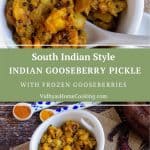
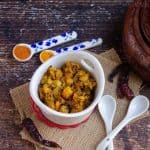

Leave a Reply